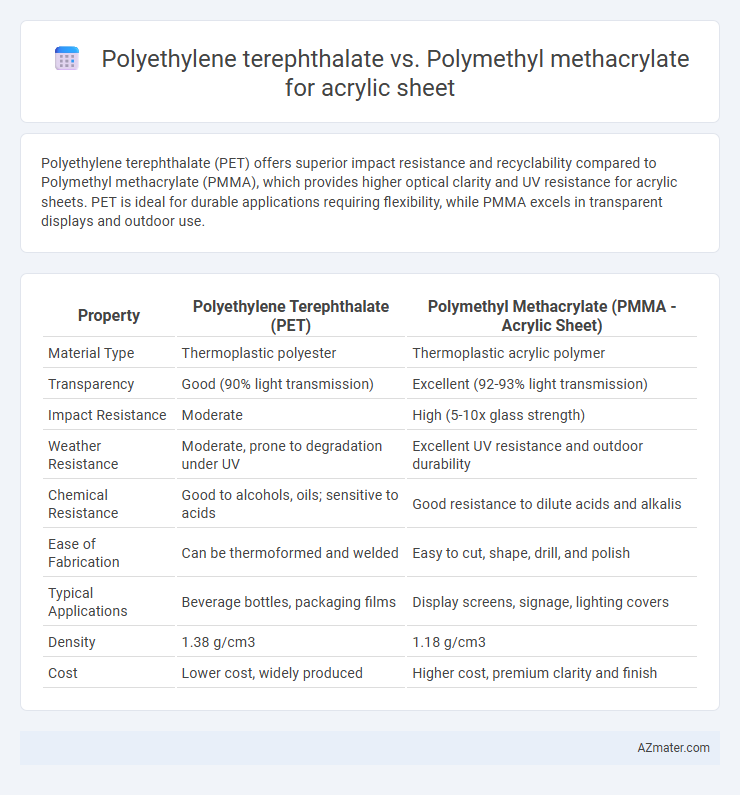Polyethylene terephthalate (PET) offers superior impact resistance and recyclability compared to Polymethyl methacrylate (PMMA), which provides higher optical clarity and UV resistance for acrylic sheets. PET is ideal for durable applications requiring flexibility, while PMMA excels in transparent displays and outdoor use.
Table of Comparison
| Property | Polyethylene Terephthalate (PET) | Polymethyl Methacrylate (PMMA - Acrylic Sheet) |
|---|---|---|
| Material Type | Thermoplastic polyester | Thermoplastic acrylic polymer |
| Transparency | Good (90% light transmission) | Excellent (92-93% light transmission) |
| Impact Resistance | Moderate | High (5-10x glass strength) |
| Weather Resistance | Moderate, prone to degradation under UV | Excellent UV resistance and outdoor durability |
| Chemical Resistance | Good to alcohols, oils; sensitive to acids | Good resistance to dilute acids and alkalis |
| Ease of Fabrication | Can be thermoformed and welded | Easy to cut, shape, drill, and polish |
| Typical Applications | Beverage bottles, packaging films | Display screens, signage, lighting covers |
| Density | 1.38 g/cm3 | 1.18 g/cm3 |
| Cost | Lower cost, widely produced | Higher cost, premium clarity and finish |
Introduction: PET vs PMMA in Acrylic Sheet Applications
Polyethylene terephthalate (PET) and polymethyl methacrylate (PMMA) are prominent materials in acrylic sheet applications, each offering unique chemical and physical properties. PET sheets boast excellent impact resistance, flexibility, and recyclability, making them suitable for packaging and lightweight protective barriers, while PMMA sheets provide superior optical clarity, UV resistance, and weatherability, ideal for high-visibility displays and outdoor signage. The selection between PET and PMMA largely depends on application-specific requirements such as durability, transparency, and environmental exposure.
Chemical Structure and Composition
Polyethylene terephthalate (PET) is a polyester composed of repeating units derived from ethylene glycol and terephthalic acid, characterized by ester linkages in its polymer backbone. Polymethyl methacrylate (PMMA) is a synthetic polymer made from methyl methacrylate monomers, featuring a carbon-carbon backbone with pendant methyl ester groups. The chemical structure of PET imparts durability and chemical resistance due to its aromatic rings, while PMMA's acrylic composition offers superior clarity and UV resistance ideal for transparent acrylic sheets.
Physical and Mechanical Properties
Polyethylene terephthalate (PET) offers excellent tensile strength and impact resistance, making it highly durable for various applications, while polymethyl methacrylate (PMMA) provides superior optical clarity and scratch resistance but is more brittle. PET exhibits higher flexibility and better chemical resistance compared to PMMA, which tends to be stiffer yet more prone to cracking under stress. Both materials have similar density ranges, but PET's better thermal stability enhances its mechanical performance under variable environmental conditions.
Optical Clarity and Light Transmission
Polyethylene terephthalate (PET) offers excellent optical clarity with light transmission rates typically around 85-90%, making it suitable for applications requiring clear visibility and durability. Polymethyl methacrylate (PMMA), commonly known as acrylic, provides superior optical clarity with light transmission rates up to 92%, delivering the highest transparency among common plastics. PMMA sheets are preferred for applications demanding exceptional clarity and minimal distortion, while PET provides a balance of clarity and impact resistance.
Durability and Weather Resistance
Polyethylene terephthalate (PET) offers high impact resistance and excellent durability, making it highly suitable for applications requiring robust acrylic sheets. Polymethyl methacrylate (PMMA) provides superior weather resistance with outstanding UV stability, maintaining clarity and structural integrity in prolonged outdoor exposure. While PET excels in toughness, PMMA is preferred for long-term outdoor use due to its exceptional resistance to yellowing and environmental degradation.
Fabrication and Machinability
Polyethylene terephthalate (PET) offers excellent machinability with high impact resistance and flexibility, making it suitable for complex fabrication processes such as thermoforming and laser cutting. Polymethyl methacrylate (PMMA), known as acrylic, provides superior clarity and surface finish but is more brittle, requiring careful handling during machining to avoid cracking or chipping. PET's chemical resistance and easier post-processing make it advantageous for applications demanding durability, while PMMA excels when optical properties and precision in cutting and polishing are prioritized.
Cost Analysis and Market Availability
Polyethylene terephthalate (PET) sheets generally offer a lower cost advantage compared to polymethyl methacrylate (PMMA) acrylic sheets due to cheaper raw materials and more efficient manufacturing processes. PET also benefits from greater market availability and widespread use in packaging and industrial applications, making it easier to source globally. While PMMA provides superior optical clarity and weather resistance, its higher price point limits its use to premium applications despite steady market demand.
Environmental Impact and Recyclability
Polyethylene terephthalate (PET) and polymethyl methacrylate (PMMA) exhibit differing environmental impacts and recyclability profiles as materials for acrylic sheets. PET is highly recyclable through established bottle-to-bottle recycling streams, reducing landfill waste and energy consumption due to its thermoplastic nature and widespread collection infrastructure. PMMA, while offering superior optical clarity and weather resistance, is less commonly recycled, often requiring energy-intensive processes that limit its environmental sustainability compared to PET.
Common Uses in Industry and Design
Polyethylene terephthalate (PET) is widely used in the packaging industry due to its excellent chemical resistance, clarity, and recyclability, making it ideal for bottles, containers, and flexible films. Polymethyl methacrylate (PMMA), commonly known as acrylic sheet, is favored in design and architectural applications for its superior optical clarity, weather resistance, and ease of fabrication, often utilized in signage, displays, and skylights. Both materials serve distinct industrial and design needs, with PET dominating packaging solutions and PMMA excelling in decorative and structural applications.
Choosing the Right Material for Your Project
Polyethylene terephthalate (PET) offers excellent chemical resistance and high impact strength, making it ideal for applications requiring durability and flexibility, while polymethyl methacrylate (PMMA), commonly known as acrylic, provides superior optical clarity and UV resistance, perfect for aesthetic and outdoor projects. When choosing the right material for your project, consider PET for cost-effective solutions with mechanical resilience, and PMMA for visually appealing, lightweight, and weather-resistant panels. Evaluating factors such as transparency needs, environmental exposure, and mechanical stress ensures optimal performance and longevity of acrylic sheet applications.

Infographic: Polyethylene terephthalate vs Polymethyl methacrylate for Acrylic Sheet
 azmater.com
azmater.com